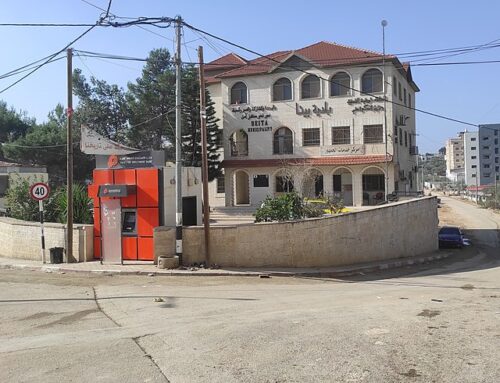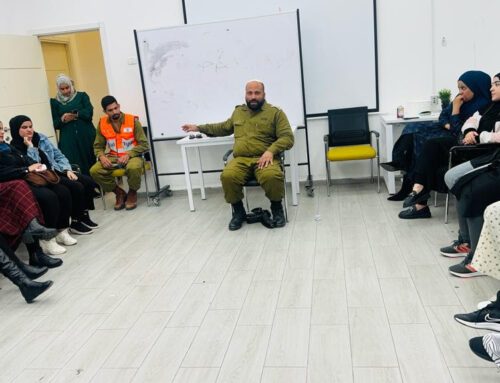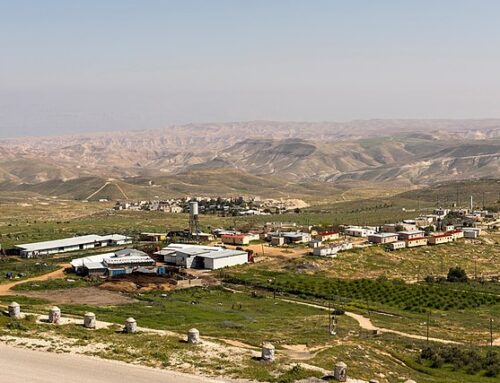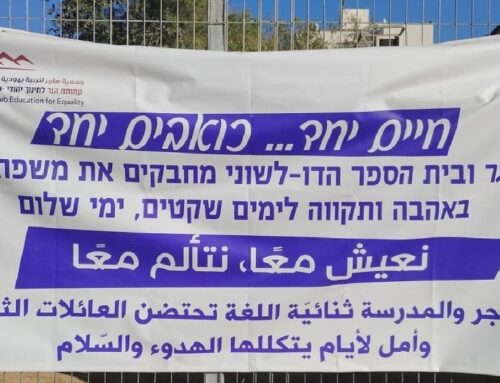After spending most of January in Israel, Palestine and Jordan as part of Meretz USA’s annual “Israel Symposium”, I’m now back in the States and it’s both my duty and my pleasure to report back on what I learned.
First, the headlines:
- 2008 is shaping up as a critical, perhaps make-or-break, year for the future of the two-state solution to the Israel/Palestine conflict.
- The human rights situation in the territories is steadily deteriorating, as the system of checkpoints / closures / travel restrictions calcifies, turning from ad hoc security measure to an accepted, unquestioned form of ongoing control.
- The American Jewish community has a crucial role to play in bolstering the courageous efforts of Israeli and Palestinian peace activists.
Now for these stories, in depth…
Twenty-six participants took part in the 2008 Meretz USA Israel Symposium, which this year included some wonderful new friends from the Brit Tzedek V’Shalom organization. During our time in Israel and Palestine (ten of us also continued to Jordan for four days), we rose early and went to sleep late, as we examined the state of the peace process and the occupation, and compared notes with literally dozens of Israelis and Palestinians (and Jordanians) – both public figures and “regular folks”.
It’s essentially impossible to summarize such a profusion of activity in a single paragraph, but here goes: We met with leading politicians, Israeli and Palestinian (including Israel’s Prime Minister Olmert at the Knesset and Palestine’s Prime Minister Fayyad in Ramallah), with intellectuals, journalists and members of peace think-tanks and NGOs. We met with members of a West Bank settlement, as well as with activists trying to limit the damage being wrought by the settlement enterprise. We toured the ghost-town-like streets of the Israeli-controlled section of Hebron (“H2”) where travel restrictions severely limit even Palestinian pedestrian traffic; and we were hosted by a Palestinian family in “H2” that is trying to maintain the semblance of a normal life under a harsh occupation regime in which the settlers’ interests are all that seem to matter.
Make-or-break for the two-state solution?
There was so much more, but the real story isn’t whom we met, but what we heard, and what we heard most often was this: 2008 could be the last year in which a two-state solution for Israel/Palestine is still possible. In other words, we were told, if the two-state vision isn’t realized this year, we might not get another crack at it.
Why is this so? First and foremost, due to growing Palestinian disillusionment. A constant refrain in our discussions was that, from the Palestinian perspective, the 15 years since the Oslo process began have witnessed a sharp rise in settlement expansion, an ever more trenchant occupation regime, and a steep decline in Palestinian standard of living. With no real results to show for the talks over a two-state solution, Palestinian intellectuals, and an increasing number of “men and women in the street”, are starting to believe that instead of pounding their head on the wall of the peace process, the Palestinians should start changing their tune: Instead of demanding an independent Palestinian state, they should turn to the international community and ask that Israel simply apply to the residents of the territories the basic democratic rule: One person, one vote. Despairing of a two-state solution, we were told, the majority of Palestinians might soon go back to their old demand for a single democratic state between the Jordan River and the Mediterranean Sea – in which they would constitute a majority by the year 2020 or earlier.
The year 2008 is also seen as critical due to the way in which the stars are lined up in the political firmament. US engagement is regarded as an absolute necessity, but the common logic is that no first-term American president in his/her first two years in office will want to get involved in such an explosive issue as Israel/Palestine. In other words, 2008, President Bush’s last year in office, could well be the last opportunity for active American involvement in the peace process until 2011 – by which time, we were warned, it might be too late. In addition, figures on both sides told us, Palestinian President Abbas is set to complete his term this year and will not seek re-election; if no major progress towards a peace agreement is made by the time he leaves office, the Palestinian moderates will suffer a terrible political blow, and could easily lose control of the Palestinian presidency, as well as of the West Bank.
On the Israeli side: The latest public opinion polls indicate that if, amid the multiple scandals surrounding Olmert, new elections were called, the Likud party would be the clear favorite to form the next government, with its chairman, Bibi Netanyahu, becoming Prime Minister. A failure by Olmert to advance towards peace this year would only increase Israeli pessimism, and the Likud’s fortunes in the polls. We met with Bibi during the Symposium, and we heard the chilling vision of what his premiership would bring: A return of the “no Palestinian partner for peace” mantra, the suspension of the peace process, and continued Israeli control of the West Bank, with limited Palestinian autonomy to be allowed for Palestinian cities and towns. Indeed, faced by this electoral and political prospect, the Meretz party in Israel finds itself in a quandary: Should it call for Olmert’s ouster, and risk ushering in an Israeli government that will tightly close the spigot on peace? Or should it “hold its nose” and keep Olmert afloat, in the hope that his stated commitment to the peace process is sincere?
Finally, the reality of the settlements on the ground is threatening to make the two-state solution a relic of the past. For a Palestinian state to be viable, it will need to occupy a contiguous territory, whose political, cultural and administrative capital will be in East Jerusalem. Increasingly, however, Israeli settlement activity is threatening to cut off East Jerusalem from the rest of the West Bank, which would render a future Palestinian state a body without a head. Daniel Seidemann of the Ir Amim organization explained that, in particular, Israeli construction in Har Homa, between Jerusalem and Bethlehem, and plans for construction in the “E-1” area, between Jerusalem and the mega-settlement of Ma’aleh Adumim to its east, could finally and terminally sever East Jerusalem from its Palestinian hinterland.
Human rights and occupation
Meanwhile, as Israeli and Palestinian public figures fight to preserve the two-state concept, Palestinian life in the territories becomes increasingly unlivable. Yehuda Sha’ul of the IDF rerservists group, “Breaking the Silence”, informed us, for example, that 42% of the Palestinian homes in the Israeli-controlled section of Hebron are now empty, due to the constant pressure and abuse of the Israeli settlers, and the tight restrictions imposed by the Israeli army – designed to protect the Israeli settlers at the expense of the Palestinian population. (For information on Breaking the Silence’s February/March tour and photo exhibit in Philadelphia, Boston and New York, click here.)
We learned from Lydia Aisenberg of Givat Haviva that tens of thousands of Palestinians are caught between the Israeli separation barrier to their east and the Green Line to their west. Caught in “limbo-land”, as she put it, they are both forbidden to cross into Israel and hard-pressed to access the Palestinian areas on the other side of the fence and wall, where they have land, family and friends, and receive their medical services.
We learned from Hanna Barag of Machsom Watch that, despite Olmert’s commitments, the number of checkpoints within the West Bank has not decreased, with some 550 checkpoints still allowing the settlers to move about the West Bank freely while tightly filtering, and sometimes preventing entirely, the movement of Palestinians. Indeed, one of the nagging questions that arose repeatedly was whether the Israeli government was in full control of its bureaucracy – both military and civil. How else to explain the gap, indeed sometimes the diametrical contradiction, between Israeli government promises on checkpoints and settlements and the darkening reality on the ground?
As we traveled the West Bank, our bus moved effortlessly on a no-Palestinians-allowed highway that had a high wall running alongside its entire length. The wall seemed to serve a dual purpose: Not only to block the potential attacks of Palestinian terrorists, but to shield Israeli eyes from the fact that there are people – Palestinian people – on the other side: Out of sight, out of mind, as it were. The deepening of the occupation, it seems, is not only about the restrictions in effect on the West Bank and all around Gaza. It is manifested as well in a growing Israeli indifference to the condition of their Palestinian neighbors – an apathy and numbness bred of the same frustration and despair that is fueling the Palestinian disillusionment with the two-state idea.
American Jews can and must help!
But all is not lost. Time and again we were told that the Palestinian and Israeli political leaderships have never been closer to an actual peace agreement. Much of the real work is being done “under wraps”, and the gaps are narrowing significantly. But time is of the essence, and these efforts need as much support as possible. As a result, we heard from Israelis and Palestinians alike how important it is that progressive American Jews make their voice heard, loud and clear.
Gadi Baltiansky, chairman of the Israeli chapter of the Geneva Initiative explained that American Jews can have an impact in three ways: First, American decision-makers need to hear that the American Jewish community demands continuous US engagement in the peace process. Second, he noted, Israeli decision-makers, too, will take into account what American Jews have to say. Finally, he pointed out, since the beginning of the Second Intifada, the Israeli Jewish public has been put to sleep by the refrain that peace is not possible. An American Jewish voice in support of the peace process, he predicted, could help wake their Israeli cousins from their slumber, and make peace seem “real” and “possible” once again. It’s time not only for American Jewish moderates to have their say, Gadi implored, it’s time for them, “to shout”.
Let’s start shouting.
Ron Skolnik
Executive Director
Meretz USA






If its “now or never” in 2008 than it is never. Peace process historian William Quandt wrote in his book on Camp David I (Camp David: Politics and Peace Making)that no progress is possible in either the fourth or eighth years of a president’s terms as he is running for reelection in his fourth year and a lame duck with little power in his last year. This especially applies to the present incumbent because of Iraq, his national unpopularity, and the revolt of his party. Quandt also said that most of a president’s first year will be spent in regional familiarization and policy formulation. This might not apply to Hillary, because of her husband, but would certainly apply to Obama, and to a lesser extent to McCain. Quandt claims that a president’s most productive years are his second, third, fifth, sixth, and seventh. But as no president can automatically count on a second term they have to count on making peace in the second and third years–2010 and 2011. But the Palestinians are unlikely to find either the Israelis or the Americans going along with their plans. The Europeans are also unlikely to acquiesce readily in the abandonment of the two-state solution.